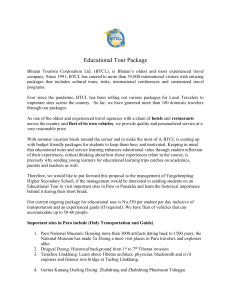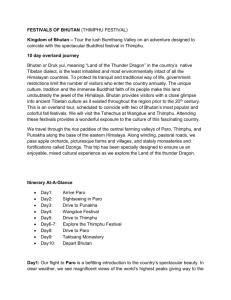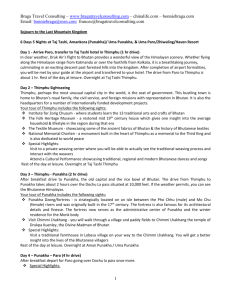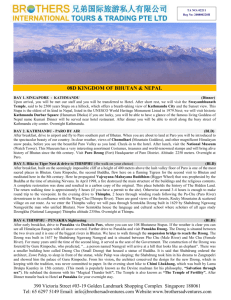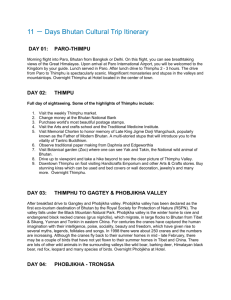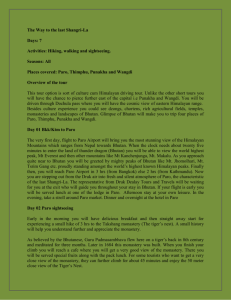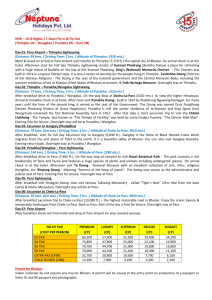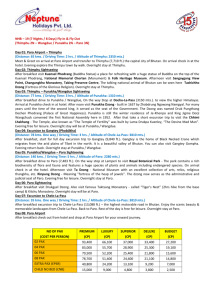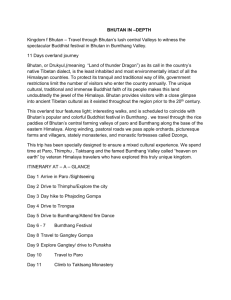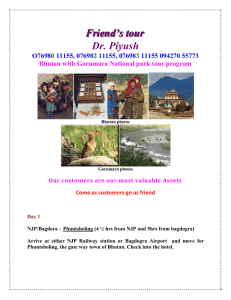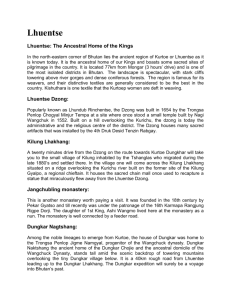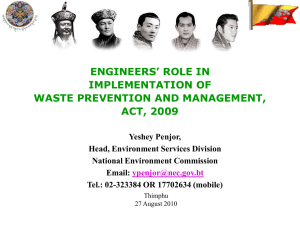Druk Path Trek and Cultural Tour Duration: Six days, Maximum
advertisement
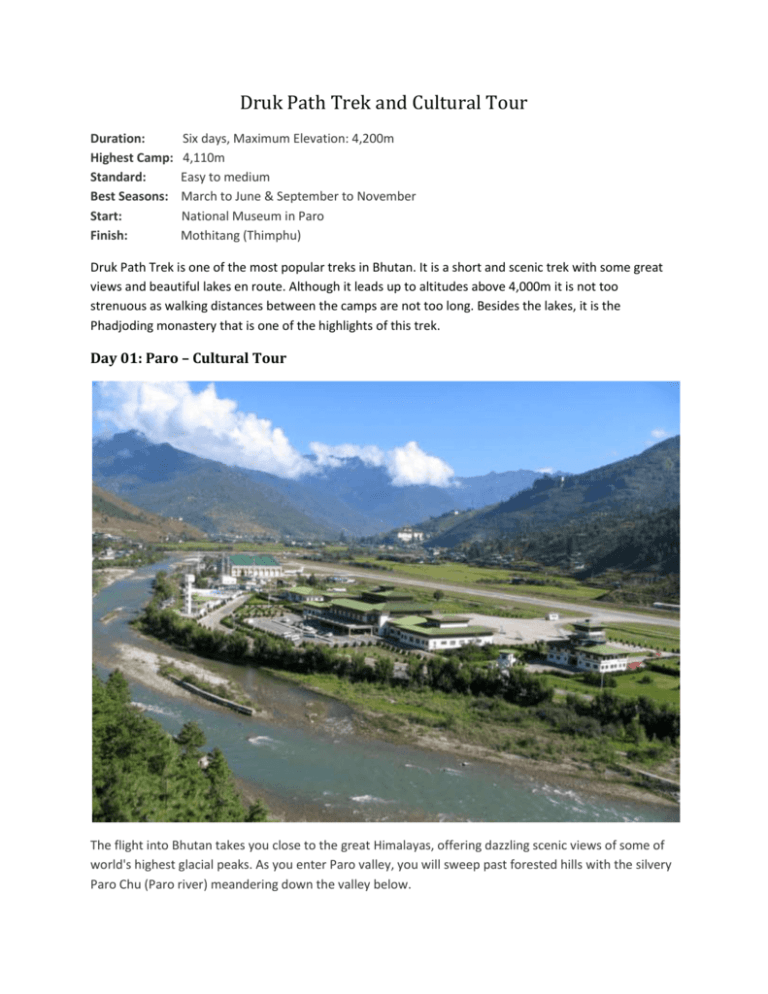
Druk Path Trek and Cultural Tour Duration: Highest Camp: Standard: Best Seasons: Start: Finish: Six days, Maximum Elevation: 4,200m 4,110m Easy to medium March to June & September to November National Museum in Paro Mothitang (Thimphu) Druk Path Trek is one of the most popular treks in Bhutan. It is a short and scenic trek with some great views and beautiful lakes en route. Although it leads up to altitudes above 4,000m it is not too strenuous as walking distances between the camps are not too long. Besides the lakes, it is the Phadjoding monastery that is one of the highlights of this trek. Day 01: Paro – Cultural Tour The flight into Bhutan takes you close to the great Himalayas, offering dazzling scenic views of some of world's highest glacial peaks. As you enter Paro valley, you will sweep past forested hills with the silvery Paro Chu (Paro river) meandering down the valley below. Paro Dzong (fortress) and Ta Dzong (National Museum) on the hills above the town will be a fine sight. Our representative will meet you at Paro airport and drive to Bhutan's capital, Thimphu, an exciting blend of tradition and modernity. Check in to the hotel. Druk Path Trek Day 02: Paro – Jili Dzong (Distance seven km, four to five hours, 1,090m ascent, camp altitude 3,480m). The first day is a long day as you have to climb more than 1,000m elevation. You start from the Ta Dzong (National Museum) in Paro. The trek follows a gravel road past a few farms for about 30 minutes and then climbs up a steep ridge before leading through blue pine and fir forests to Damche Gom. Once you reach the ridge below Jili Dzong you descend about 100m to the campsite below Jili Dzong. Day 03: Jili Dzong – Jangchulakha (Distance 10 km, four to five hours, 310m ascent, 50m descent, camp altitude 3,770m). You begin with a climb for about an hour and a half and then ascend gradually up. The trail takes you through thick alpine forest and dwarf rhododendron tress. You may see yaks and yak herders around your campsite. Day 04: Jangchulakha – Jimilang Tsho (Distance 11 km, four hours, 230m descent, 330m ascent, camp altitude – 3,870m). The trail follows the ridge and on a clear day the view of the mountains and valley are beautiful. The campsite is close to the Jimilang Tsho Lake. The lake is known for its giant sized trout. Day 05: Jimilang Tsho – Simkotra Tsho (Distance 11 km, four hours, 820m ascent, 400 m descent, camp altitude 4,110m). The trail takes you through dwarf rhododendron trees and Janetso Lake. You may come across some yak herder’s camps where you will have the opportunity to get a glimpse of a nomad’s life. The campsite is close to Simkotra Tsho Lake. Day 06: Simkotra Tsho – Phajoding (Distance 10 km, three to four hours, 130m ascent, 680m descent, camp altitude 3,750m). The trek begins with a gradual climb. If the weather permits, you will have a spectacular view of Mount Gangkar Puensum, the highest mountain in Bhutan and other Himalayan peaks. From this pass, the trek takes you downhill to Phajodhing for a nights halt. The camp is above Phadjoding. Day 07: Phajodhing – Mothitang (Distance fur to five km, three hours, 1,130 m descent). After passing Phadjoding monastery, the trek to Thimphu (Mothitang) is all the way downhill through a forested area of mostly blue pine. The walk, at a leisurely pace, takes about three hours. Day 08: Thimphu Start exploring from BBS view point then visit mini zoo. The reserve of Bhutan’s national animal called Takin. Also visit Jungshi Handmade Paper Factory on your way from the mini zoo. National Library, which holds a vast collection of ancient Buddhist texts and manuscripts, some dating back several hundred years, as well as modern academic books mainly on Himalayan culture and religion. Visit King's Memorial Chorten continuously circumambulated by people, murmuring mantras and spinning their prayer wheels. Construction of this landmark was the idea of Bhutan's third king, His Majesty Jigme Dorji Wangchuk ("the father of modern Bhutan") who has wished to erect monument to world peace and prosperity. Completed in 1974 after his untimely death, it serves both as a memorial to the Late King and as a monument to peace. Later visit Buddha statue at the Kuenselphodrang. This statue is constructed to benefit all the sentient beings of the world. You have the advantage of visiting this sight now owing to its construction; once it’s completed the place will turn into a major pilgrimage site. Also visit Trashichhoedzong, "fortress of the glorious religion". This is the center of government and religion, site of monarch's throne room and seat of Je Khenpo or Chief Abbot. Built in 1641 by the political and religious unifier of Bhutan, Shabdrung Ngawang Namgyal, it was reconstructed in 1960s in traditional Bhutanese manner, without nails or architectural plan. Institute for Zorig Chusum (commonly known as The School of Arts & Craft where students undertake a six-year course on the 13 traditional arts and crafts of Bhutan; Textile and Folk Heritage Museum: These museums, both of which opened in 2001, provide fascinating insights into Bhutanese material culture and way of life. Handicrafts Emporium: This government-run enterprise displays a wide range of beautifully handwoven textiles and craft products. It also carries a small collection of books on Bhutan, Buddhism and Himalayan culture. Overnight at Thimphu Day 09: Punakha Punakha (alt. 1300m/4265ft)- After breakfast proceed to Punakha via Dochula pass (3,080m) stopping briefly here to take in the view and admire the chorten, mani wall, and prayer flags which decorate the highest point on the road. If skies are clear, the following peaks can be seen from this pass (left to right): Masagang (7,158m), Tsendagang (6,960m), Terigang (7,060m ), Jejegangphugang (7,158 m ), Kangphugang (7,170 m ), Zongphugang (7, 060 m ), a table mountain that dominates the isolated region of Lunana - finally Gangkar puensum, the highest peak in Bhutan at 7,497m. After Lunch visit Chimi lhakhang. The temple is famously known to outsider as the ‘Fertility Temple’ you should examine the blessing tool careful for Later visit Punakha Dzong, built strategically at the junction of Pho Chhu and Mo Chhu rivers in 1637 by Shabdrung Ngawang Namgyal to serve as the religious and administrative centre of the region, Punakha Dzong has played an important role in Bhutan's history. Damaged by four catastrophic fires and an earthquake, the Dzong has now been fully restored. Overnight at the hotel in Punakha Day 10- Gangtey/Phobjikha Gangtey & Phobjikha (alt. 3000m/9845ft)- After breakfast drive to Phobjikha. You can stop to take photograph of the Wangdi Dzong in Ruins. The Dzong was burnt down due to short circuit. Fortunately most of the important relics and statue were recovered. There is an abrupt change in vegetation at this point, with mountain forest replaced by high altitude dwarf bamboo. The valley of Gangtey is one of the most beautiful spots in Bhutan. The surprise of finding such a wide, flat valley without any trees after the hard climb through dense forests is augmented by an impression of vast space, and extremely rare experience in Bhutan where most of the valley’s are tightly enclosed. A few kilometers beyond the Gangtey Monastery, on the valley floor lies the village of Phobjikha. This place is the winter home of black necked cranes that migrate from the arid plains in the north to pass winter in milder and lower climate. Phobjikha, at an altitude of 2900 m, falls under the district of Wangduephodrang and lies on the periphery of the Black Mountain National Park. The valley boasts two beautiful meandering rivers, Nakay Chhu (Chhu Naap-black water) and Gay Chhu (Chhu Karp-white water). Black Necked Crane Information Centre- Situated on the edge of the forest and wetland along the main road of Phobjikha valley, the blacknecked crane information Centre has an observation room equipped with high power telescope and spotting scopes for catching the best view of the cranes. The centre also offers display information that outline the natural and cultural history of the area. There is a small gift shop, which sells handicrafts produced by the local people. According to a local legend, the two rivers actually represent a snake and a boar. The two animals once raced each other with an agreement that if the snake (Nakay Chhu) won, Phobjikha valley would be able to grow rice, but if the boar won, then rice could never be cultivated in the area. The snake lost since it had to meander all the way during its journey. Rice cannot be cultivated in the valley even today. Overnight at the lodge in Gangtey / Phobjikha. Day 11: Paro Drive back to Paro. Overnight at Paro Day 12: Departure.
